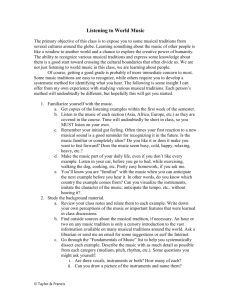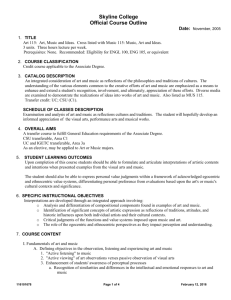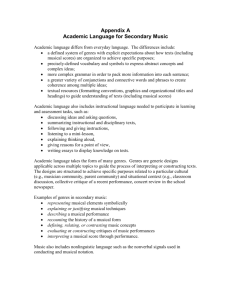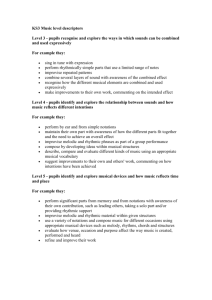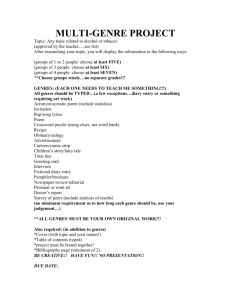The Garland Handbook of Latin American Music
advertisement
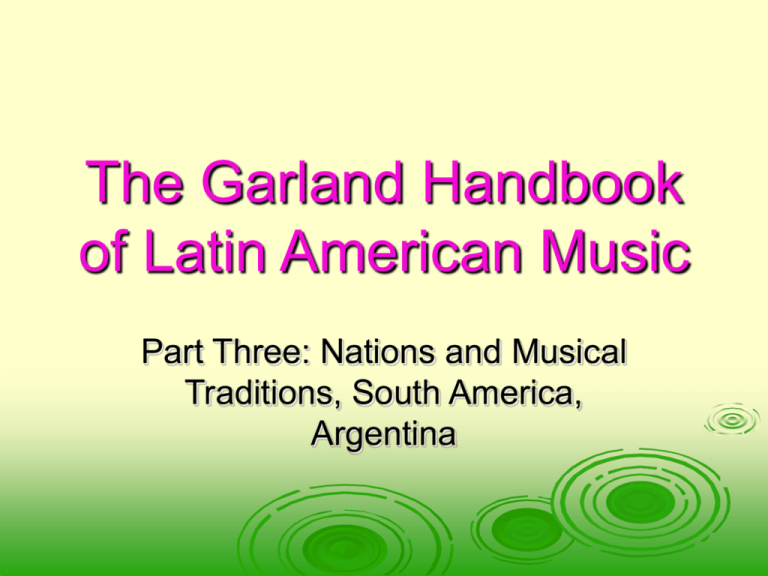
The Garland Handbook of Latin American Music Part Three: Nations and Musical Traditions, South America, Argentina Cultural Heritage Indigenous Contemporary musical traditions parallel those of other indigenous communities throughout Latin America • Type of instruments • Relationship between instruments, contexts, genres, and beliefs • Use of music means of facilitating transformation (physical and/or spiritual) and communication in ritual contexts i.e., the Kultrún African Influence minimal Presence in contemporary Argentine music culture primarily influence of AfroBrazilian religious traditions • i.e., Umbanda and Batuque European Influence most prevalent in contexts and genres introduced by, or derived from Roman Catholic Church • Contemporary celebrations and rituals reflect unique development of Catholic Church in Latin America Contexts include: Saint-day celebrations (Patronal festivals), holy week, funeral rituals Contemporary Argentine Musical Traditions Secular genres Reflect greater social processes also evident in other parts of Latin America • Also particular socio-historical, political circumstances surrounding emergence and development (i.e., migration, public policy, etc.) Nationally and internationally recognized secular genres Tango • Music and dance genre (late nineteenth century) Ensemble epitomized by bandoneón • Small button accordion (or concertina, of German influence) • Development influenced by new contexts, audiences, and technological advancements (film and radio) • Resurgence in 1970s and 1980s parallels recovery of tango as a dance genre Note: consider significance of dance in secular musical traditions throughout Latin America Contemporary Argentine Musical Traditions Nationally and internationally recognized secular genres Folkloric music • Reflects both revivalist and nationalist interests Response to experience of urban immigration, also foreign musical influences and political circumstances • Development spurred by emerging contexts (i.e., festivals and peñas), and the activity of itinerant artists and researchers • Include both traditional rural genres and contemporary songs inspired by, or based on them Rock • Development reflects shifting historical social and political dynamics in Argentina • Also reflects advances in technology and role of media • Until recently, primary source of social and political expression for disenfranchised youth • Incorporates diverse musical elements from various international popular musics Music, Politics, and Identity Argentine folkloric and popular music, and national identity Throughout Latin America, social, historical, economic, and political events and developments inform and shape musical traditions and social identities Consider how such events and economic developments have impacted musical traditions in Argentina (especially folkloric and popular music) Questons for discussion • How did more recent immigrant communities and urban migration contribute to the development and popularity of folkloric music? What economic factors contributed? • How does the development of Argentine rock reflect the changing social and political dynamics in Argentina? • What role did technology and the media play in Argentine rock’s national and international success? • How did public policy impact the development of Argentine folkloric and popular music? • How might the development of these genres compare with that of popular music elsewhere in Latin America or elsewhere?
